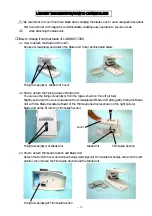
5502A
Operators Manual
9-22
Each option in the Marker menu is given below.
•
OUTPUT @ SCOPE terminal (50
Ω
)
Shows the location of the signal output. If
the signal does not show on the oscilloscope, push
. To disconnect the signal,
push
.
•
SHAPE
Shows the type of waveform. With reference to the frequency setting,
possible selections are sine, spike, square (50 % duty cycle square wave), and sq20%
(20 % duty cycle square wave.) Note that selections available under SHAPE refer ton
the selected marker period (frequency) as follows:
Selection Period
(Frequency)
Sine
10 ns – 2 ns (100 MHz – 500 MHz)
Spike
5 s – 20 ns (0.2 Hz – 50 MHz)
Square
5 s – 10 ns (0.2 Hz – 100 MHz)
Sq20%
20 ms – 100 ns (50 kHz – 10 MHz)
•
TRIG
If you use the external trigger, use this key to move through the trigger
settings. The available trigger settings are: off, /1 (trigger signal shows on each
marker), /10 (trigger signal shows on every tenth marker), and /100 (trigger signal
shows on each 100 markers). You can also toggle the trigger off and on. Push the
TRIG OUT key.
•
MODE
Shows you are in Marker mode. Use the softkey to change modes and open
the related menus for the other four oscilloscope calibration modes.
Default marker values are 1.000 ms, SHAPE = spike.
The
and
keys step the voltages through cardinal point values of an
oscilloscope in a 1-2-5 step sequence. For example, if the period is 1.000 ms, push
to increase the period to the nearest cardinal point, which is 2.000 ms. Push
to
decrease the voltage to the nearest cardinal point, which is 500
μ
s.
Time Base Marker Calibration Procedure for an Oscilloscope
This sample procedure uses the Time Marker function to examine the horizontal
deflection (time base) of your oscilloscope. See the manual for your oscilloscope for the
time base values recommended for calibration.
Before you start this procedure, verify that you are in Marker mode. If you are, the
Control Display shows the subsequent menu, see below.
gjh060.eps
Do the subsequent sample procedure to calibrate the time base.
1.
Connect the Calibrator to Channel 1 on the oscilloscope. Select 50
Ω
impedance or
use an external 50
Ω
termination. Make sure the oscilloscope is dc-coupled.
2.
Apply a time marker value. Refer to the recommended calibration settings in your
oscilloscope manual. For example, to record 200 ns, push
, then push
.
Содержание 5502A
Страница 4: ......
Страница 12: ...5502A Operators Manual xii ...
Страница 46: ...5502A Operators Manual 2 2 ...
Страница 52: ...5502A Operators Manual 2 8 ...
Страница 54: ...5502A Operators Manual 3 2 ...
Страница 70: ...5502A Operators Manual 3 18 S1 S to T to S1 gvx032 eps Figure 3 4 SETUP Softkey Menu Displays cont ...
Страница 142: ...5502A Operators Manual 4 68 ...
Страница 193: ...6 1 Chapter 6 Remote Commands Title Page Introduction 6 3 Command Summary by Function 6 3 Commands 6 10 ...
Страница 194: ...5502A Operators Manual 6 2 ...
Страница 240: ...5502A Operators Manual 7 2 ...
Страница 260: ...5502A Operators Manual 7 22 ...
Страница 261: ...8 1 Chapter 8 Accessories Title Page Introduction 8 3 Rack Mount Kit 8 4 IEEE 488 Interface Cable 8 4 5500A LEADS 8 4 ...
Страница 262: ...5502A Operators Manual 8 2 ...
Страница 365: ...B 1 Appendix B ASCII and IEEE 488 Bus Codes ...
Страница 366: ...5502A Operators Manual B 2 ...
Страница 368: ...5502A Operators Manual B 4 ...
Страница 378: ...5502A Operators Manual D 6 ...
















































